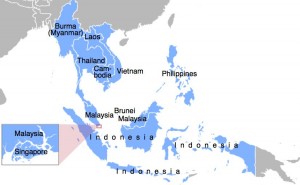India-ASEAN Connectivity Can Pave Way For GVC Manufacturing Network – Analysis
The transformational change in the manufacturing practices reveals that the development of sectoral growth and labour intensive industries are not the panacea for Make in India success. Sectoral growth or growth of traditional industries, such as textile, leather, agro based industries, cannot act as springboards for India to become global manufacturing hub, lest it becomes party to GVC (Global Value Chain) value added manufacturing network.
World manufacturing has entered into a new arena , where GVC plays a crucial role for the sake of low cost production. To this end, labour intensive industries in developing countries have worked well in the GVC manufacturing network. Automobile, electronics and the digitization are the heydays for world manufacturing. India is required to fit into this GVC network for the success of Make in India.

Firms in developed countries have established transnational manufacturing network , combining their high tech know how – with lower wage labour in developing countries. Eventually, production has become increasingly fragmented across the borders through growing prevalence of GVC for production of components and parts in low wage countries. Initially, South East and East Asia exemplified this new pattern of production.
So far, India trailed behind in this race. Reasons, there were lack of adequate skilled labor, lackluster export infrastructure, limitation of scale and difficulty in accessing cheap credit. These economic ills shadowed India’s potential as manufacturing exporter and became detrimental for it to enter the GVC network of manufacturing.
Success of GVC manufacturing network depends on how the component makers, dubbed “Supporting Industries”, function efficiently to upgrade technology, which are required for the assemblers. Asian car production by Toyota Motor Company is a case in point. To cut costs and re-enter into competitiveness , the Japanese company, after the Japanese currency yen appreciated, adopted GVC system of manufacturing to produce their Asian car model . It set up a five country base network for auto part production in between four ASEAN countries and India. It set up production facilities for diesel engine, press parts, axle in Thailand, manual transmission ( middle type) in Philippines, engine computer in Malaysia, gasoline engine and door lock in Indonesia and manual transmission ( large type) in India.
Nevertheless, opportunities sprouted with the rise in wages in China, Thailand, Malaysia and Indonesia– the main partners for GVC in East Asia and ASEAN . India pitches for low wage country despite having high growth trajectory in the world. But only the cheap wages are not enough . Technology upgradation, skilled manpower and better export infrastructure are also essentials for India to become party to GVC manufacturing network.
Even though country’s manufacturing landscape has made transformational change from traditional industries to modern industries, such as automobile and electronic industries , resulting the modern industries the trend setter, the upgradation is yet to be made to make country potent for GVC network for manufacturing, like Vietnam and other South East Asian countries. This is despite that fact that India is already engaged in multilateral FTA with ASEAN and bilateral FTAs with Malaysia and Thailand.
To be party to the GVC manufacturing network in ASEAN, how should India’s manufacturing landscape fit in, if Make in India vows for a success. India’s manufacturing sector is required to be divided into two parts. The first part should include development of natural resource base industries , such as agro base and textile, mining and metal. The second part includes component base industries , such as automobile, electronic and digitization.
It is the second part where India can be the party to GVC value added manufacturing. India can be a challenging turf to become manufacturing hub for component and parts through GVC production network. India can provide workshop for manufacturing labour intensive component and parts for developed nations. Factors , which can go in favour of India, are India’s demography dividend and the edge in low cost manufacturing over South East and East Asia countries.
But, there are hurdles also to become partners to GVC . They are lack of skill workforce and lackluster infrastructure for exports. India is yet to ramp up its bottom down skilled workforce and infrastructure for exports.
Only 2 percent of the workforce is skilled in India, compared to 40 percent in China. The reason for abysmally low skilled workforce is the formal education, which does not provide suitable skills to make candidates viable for employment. The ITIs – government run training institutes – are either poorly managed or outdated. In China, skill development is geared up by steering secondary schools students into formal skill training programme.
For infrastructure development for export, development of India – ASEAN connectivity can become a new challenge for India to become party to GVC manufacturing network. Ministry of External Affairs ( MOEF) has initiated several steps to improve the India- ASEAN connectivity under Act East Asia policy. Shipping Corporation of India ( SCI) launched India-Myanmar Container Service in 2014. Joint Working Group was set up for development of Dawei Port in Myanmar. Ministry of Shipping has decided to start the India-Bangladesh- Myanmar-Sri Lanka/ Maldives direct shipping services by SCI. Myanmar is the gateway to ASEAN. Myanmar is the only nation in ASEAN , which has both road and sea borders with India.
Today, Indian economy is globally integrated. It has become one of the important wings for global growth. To this end, polarization of Make in India on sectoral growth and labour intensive industries are not enough for success. Integration of manufacturing through GVC had become the need of the hour for Make in India success.
Automobile, electronic and digitization are the component based industries. Developed nations , particularly Japan , fragmented component manufacturing for these industries in ASEAN countries for the benefit of low cost. India too developed its automobile industry and is on the trajectory for development of electronic industries, such as mobile phone manufacturing and thrust on digitization. In this perspectives, India’s initiative to develop India- ASEAN connectivity and focus on skill development are timely attempts to make India viable for partnership to GVC manufacturing network and eject a new challenge for Make in India success.
Views are personal

